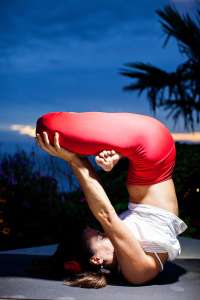They say that if a rip current is pulling you out to sea, relax and let it pull you, then swim parallel to shore until it releases you and then you can swim in. This is counterintuitive advice but it is life saving. In most cases panic sets in and people who find themselves in this dire situation behave more like salmon and swim aggressively against the current exhausting themselves and putting themselves in greater danger. There are moments in life where we will feel like we are getting pulled out to sea, losing sight of the shore. We all need to find a way to stay afloat at different times in our lives, to stay on the surface of the disturbance and not get pulled under. This is a lesson in life worth learning, because there will always be things that pull at you this way and that. You can exhaust yourself fighting it, or you can let go and float. I see people all the time in yoga that practice like salmon, working hard and throwing themselves around the room. I feel as though people don’t watch enough nature shows, because if they did, they would realize that salmon die at the end of this journey. There is a better way to practice yoga and a better way to get through the rip currents of life.

Staying afloat in Urdhva Padmasana – upward lotus.
We human beings are natural graspers. That should be an obvious truth because we have thumbs. All the grasping (Aparigraha) we do eventually becomes a pattern. It’s these patterns that we need to break. Those patterns are the rip current. Negative patterns pull us further away from the person we are capable of becoming. The shoreline symbolizing where we are at peace, with two feet firmly planted. What’s the first thing we do when we are knocked off our feet? We grasp, we reach out for anything to stop our fall. In the Ashtanga yoga invocation the chant speaks of these samaskaras (mental impressions/ patterns) and the halahala (poison) they can become. One of these patterns of grasping I find in yoga is this inability to drop our heads back physically, as well as mentally. In order to float you need to be able to just drop your head back. We don’t seem to trust our necks. It’s as if the neck symbolizes the connection from our bodies, to our minds. When energy doesn’t flow through the neck freely in becomes a holding pattern. I find it always helpful to take into consideration that we are mostly water. So why is it so hard to behave like it? Water can cut through stone. Given enough time and repetition the stone will yield. All the more reason and proof to make yoga a lifelong commitment. To give your body enough time to yield, you must repeat an action you wish to change.
The danger of a rip current lies in the fact that they can not be seen, but they can be felt. Not everything we do in yoga can be seen to the eye, but everything we do can be felt. I always say you need to approach all poses with a greater-than and lesser-than approach. Do I need more of this sensation or less? Yoga needs to be about the sensations that arise and our abilities to be sensitive and responsive to them. To not overreact, nor do too little, but to find the current of energy most productive that will carry you down the river of progress. To stay afloat in your yoga practice for years and years to come, it’s about adapting to where the body is on a daily basis. Not to how you wish it was, but to its current state. To stop fighting up-stream against what’s not and embrace what is. So many students over look the daily state of their practice because they are too busy looking at how they wish it was in the future. It’s sort of like wanting to have a baby but not wanting to be pregnant. Things take time. If students would remember to look at how far they’ve come, they might be able to see that this current they are fighting against might actually be moving them in a better direction. So maybe they should go with flow and just see where it takes them. Relax and realize that swimming upstream is only for the salmon. Just go where your practice takes you.






